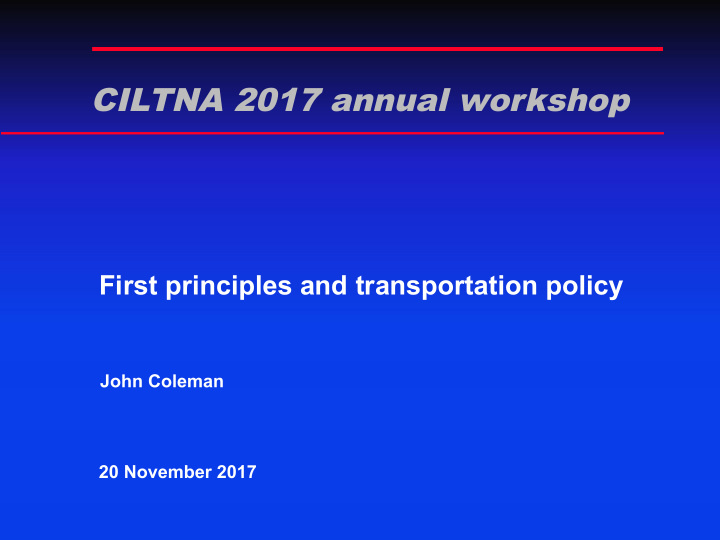



CILTNA 2017 annual workshop First principles and transportation policy John Coleman 20 November 2017
First principles Things they tried to teach us in school
Foggy language è soggy thinking Pseudo-scientific obfuscation • “This story has been optimized for offline reading on our apps” – Washington Post , article on Donald Trump, 2 November 2017 • “Carefully formulated to optimize your ownership enjoyment” – placeholder quote, surely everyone has read junk like this
First principles Ubiquitous, but always subject-specific
Aircraft carrier design Choosing the KPIs judiciously USS Gerald R. Ford (CVN 78)
Russia’s transition to a market economy Getting the process wrong • IMF demanded balanced budget, loans denominated in $US • Ruble deflated, capital fled, loans defaulted, oligarchs won • US refused nation-building aid package like Marshall Plan • First principles not sufficiently invoked: – path-dependent events – rent-taking as a function of cronyism Joseph Stiglitz George H.W. Bush Mikhail Gorbachev Margaret Thatcher Vladimir Putin Economics Economics Law Chemistry, Law Law
Moving Canada’s freight to market How systems work • Total Quality Management, Just-in-Time, Theory of Constraints – optimizing a system of production – embodied in logistics and supply-chain design – embodied in Asia Pacific Gateways and Corridors Initiative – largely ignored in C-52 and C-30, largely respected in C-49 • System stability—avoiding positive feedback loops – largely ignored in C-52 and C-30, largely respected in C-49 Edwards Deming Eliyahu Goldratt Heinrich Barkhausen Jay Forrester Mathematical physics Physics Physics, Electrical engineering Electrical engineering
Moving Canada’s freight to market Positive feedback loops • Theory originated in electrical, electronics engineering • Applies to other fields—psychology and economics – examples: run on the bank, sovereign debt crisis in Europe – sometimes called “vicious circle” or “self-fulfilling prophesy” • Economic regulation of transport çè çè congestion: Shipper dissatisfaction with railway service Congestion in Shipper complaints rail traffic movements to government Government regulation
The phenomenon of mobility Too much of a good thing Notional throughput vs . density on a traffic artery High risk zone for 20 collapse of speed and 18 throughput 16 Sweet spot Collapse of Throughput rate (vehicles / time) for undelayed speed and 14 travel throughput 12 Sweet spot 10 for maximum throughput 8 6 4 2 0 0 1 2 3 4 5 6 7 8 9 Traffic density
Financing transportation infrastructure It isn’t getting better all the time • Canada Infrastructure Works Fund (1994 – 99) • Canada Strategic Infrastructure Fund (2003 – 13) Infrastructure Canada Program (2003 – 14) • Public Transit Fund (2003 – 14) • Border Infrastructure Fund (2003 – 14) • • Municipal Rural Infrastructure Fund (2004 – 14) Federal Gas Tax Fund (2005 – ) (18 categories) • Building Canada Fund (2007 – 14) (15 priorities) • P3 Canada Fund (2007 – 14?) • • National Recreational Trails Fund (2009 – 10) Infrastructure Stimulus Fund (2009 – 12) • G8 Legacy Fund (2009 – 11) • New Building Canada Fund (2014 – ) (20+ categories) • • Community Improvement Fund Goods and Services Tax Rebate for Municipalities • Public Transit Infrastructure Fund •
Fluidity, resilience, and optimization of supply chains Going mobile • Fluidity: – embodies the concept of conveyor-belt consistency – based on optimization theory and traffic theory • Pursuit of fluidity and resilience è then optimization: – avoid / reduce / deal with variation and its effects: § decreased throughput § decreased quality of what the system produces § increased work-in-progress inventory ( = backed-up traffic) § stretched-out delivery times to end-customers § longer lead-times for customers § reduced efficiency • TC doing some leading work in pursuit of: – KPIs that are “key” – data that bring KPIs to life
Counterintuitive wisdom Thoughts from the deep • A proof is a proof. What kind of a proof? It’s a proof. A proof is a proof. And when you have a good proof, it’s because it’s proven. – Jean Chrétien • A system will optimize in the direction of the primary Goal – Eliyahu Goldratt Corollary: any KPI not based on 1 st principles is misleading • Data without theory is useless – Edwards Deming • To understand the world, the average is rarely good enough – Angus Deaton • Stochastic data fed into a deterministic system yields nothing – Chris Winkler
What to do? In conclusion • Recognize we have a problem: – too much politics, not enough policy – too little recognition of 1 st principles • Always start by figuring out the primary Goal • Sweat the determination of KPIs that crystallize “performance” • Cheer on TC’s pursuit of fluidity concepts and metrics • Insist on evidence of gains in mobility, substantiated by 1 st principles, for all transportation investments and policies • Make space at the table for people who can animate theory
What to do? In conclusion • Be nice to nerds . . . – even if “chances aren’t good that you’ll end up working for one” – with apologies to Bill Gates – because “there is nothing more frightful than ignorance in action” – Johann von Goethe
Recommend
More recommend